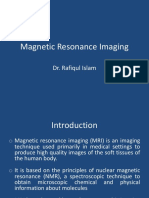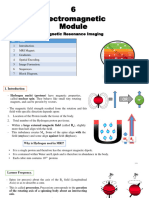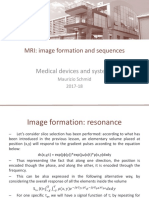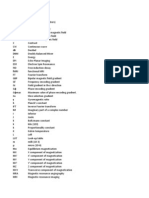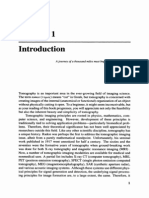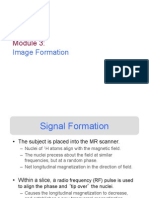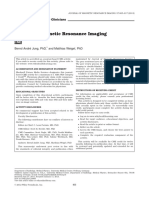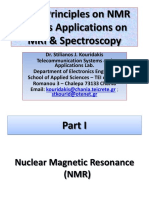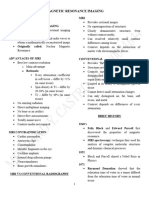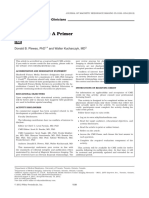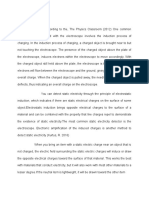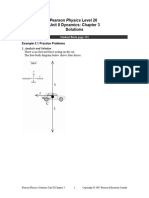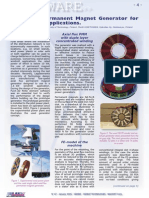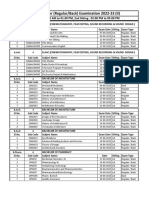Introduction to MRI
Purpose
overview MRI fundamentals and current research areas
Outline
NMR net magnetization (M) T1 and T2 relaxation (other than mechanisms) FID, SE, IR, GRE T1W, T2W, PDW image contrast image formation (excitation, k-space, phase-encode, etc.) 2D, multislice, 3D motion and flow (artifacts, angiography, quantitative flow) functional MRI other effects (magnetization transfer, chemical shift, etc.) discussion
�Joseph Fourier, 1768-1830
�Nuclear Magnetic Resonance (NMR)
nuclei with odd number of protons and/or neutrons nuclear spin angular momentum nuclear magnetic moment biological tissue
hydrogen (1H) phosphorus (31P) sodium (23Na)
�NMR
N
�NMR
when placed in a magnetic field, B0, a net magnetization vector M forms spins exhibit resonance (precess) at Larmor frequency = B
where = gyromagnetic ratio /2 = 42.58 MHz/T for hydrogen
�NMR
B0
M
no external field
external field B 0
�Net Magnetization (M)
static magnetic field B0 produces a net magnetization vector M (along z-axis)
z M B0
�NMR
excitation
a rotating magnetic field (RF), perpendicular to B0 , with frequency 0 can rotate M into the x-y plane
evolution
M will then precess freely and decay back to its equilibrium position along the z-axis
�Excitation
excitation z B0 M B0 T1 T2 x 0 y
stationary (lab) frame of reference
evolution z
x RF (B1) y
rotating frame of reference
�T1 and T2
90o 90o
RF
TR Mz recovery: T1
1 1 0.8 0.8
...
Mxy decay: T2
0.6 Mz
Signal (Mxy )
0.6
0.4
0.4
e-t/T2
(1-e-t/T1)
0.2
0.2
0 0 1 2 TR (s) 3 4
0 0 0.1 0.2 0.3 0.4 Time (s)
�Free Induction Decay s(t) = exp(-t/T2*)
1 0.8
(envelope) FID
z
Signal
0.6 0.4 0.2 0 -0.2 -0.4 -0.6 -0.8 -1 0 0.2 0.4 Time 0.6 0.8 1
x 0 y
Signal 60 50
FFT
40
spectrum
30
stationary (lab) frame of reference
20
10
0.2
0.4 Frequency
0.6
0.8
�Notes
Larmor equation
T1 = spin-lattice relaxation time T2 = spin-spin relaxation time T2* = observed FID decay time constant T2 <= T1
�T1 Contrast
1 GM 0.8 WM CSF
Mz
0.6 0.4 0.2 0 0 2
TR (s)
Signal (Mxy)
1 0.8 0.6 0.4 0.2 0 0 WM 0.1 0.2 0.3 0.4 GM CSF
SE: TR/TE = Short/Short
Time (s)
�T2 Contrast
1 GM 0.8 WM CSF
Mz
0.6 0.4 0.2 0 0 2
TR (s)
Signal (Mxy)
1 0.8 0.6 0.4 0.2 0 0 WM 0.1 0.2 0.3 0.4 GM CSF
SE: TR/TE = Long/Long
Time (s)
�PD Contrast
1 GM 0.8 WM CSF
Mz
0.6 0.4 0.2 0 0 2
TR (s)
Signal (Mxy)
1 0.8 0.6 0.4 0.2 0 0 WM 0.1 0.2 0.3 0.4 GM CSF
SE: TR/TE = Long/Short
Time (s)
�Spin-Echo
TE/2 90x TE 180y
z B0 M
b
x RF (B1) 90 y y x RF (B1) 180
b
x
a
x x
FID T2* e -t/T2*
T2 e -t/T2
Spin-echo
�Spin-Echo Contrast
converts Mz at time TR into Mxy and then measures it at a time TE later long TR, short TE -> PDW long TR, long TE -> T2W short TR, short TE -> T1W
�Inversion Recovery (IR)
180 RF TI 90 180
z B0 M
RF (B1) 180 y y
SE
Mz
1-2e-t/T1
�Inversion Recovery
can create good tissue contrast can null tissue of a selected T1 beware of real vs magnitude images and bounce artifact scan time can be rather long
�Gradient Recalled Echo (GRE)
RF
z B0 M
TR
z M z
z M
x y
gradient FID signal GRE
�Gradient Recalled Echo
faster imaging sequence (TRs as low as 1015ms) reduced flip angle shorter TR -> more T1W larger flip angle -> more T1W longer TE -> more T2*W
�GRASS Images
T1W TR/TE/ = 300ms/13ms/60o
T2*W TR/TE/ = 30ms/13ms/60o
T2*W TR/TE/ = 300ms/35ms/15o
PDW TR/TE/ = 400ms/13ms/10o
�MPGR Images
TR/TE=400/9ms
= 10
30
60
90
�Scanner Hardware
main magnet (Tesla) gradient coils (mT/m) RF coils (T (Rx))
Gradient amps
RF amp
Receiver
Computer
Display
�Typical MRI Scanner
�Image Formation
gradients cause a position dependent frequency relationship via the Larmor equation
slice select gradient frequency encode (a.k.a. readout, measurement) phase encode
�Selective Excitation
apply a gradient perpendicular to desired slice excite using an RF pulse containing a range of frequencies pulse bandwidth and gradient strength result in a slice thickness
�Slice Selection
RF slice profile
time FFT frequency
distance
G-slice B0
�MRI: 1D Localization
NMR
Real
B0 Gx Project
Imag
FFT time frequency
�Frequency Encode Gradient
gradient on during data acquisition Larmor equation gives relationship between frequency and location in one direction
�GRE Pulse Sequence
RF
slice selection
Gz Gy Gx S(t)
phase encode frequency encode signal
�Phase Encode
for each sequence repetition apply a short gradient pulse orthogonal to the frequency encode gradient increment amplitude of this pulse for each TR collect N (typically 128-256) phase encode lines reconstruct image using Fourier Transform (FFT)
�ky
2-D Imaging
FFT kx x
magnitude raw data
magnitude reconstructed image
�K-space Interpretation
received time domain signal represents the spatial frequency domain Fourier data the position in n-D k-space is given by the time integral of the gradient waveforms
�MRI
Signal equation (ignoring relaxation)
S (t ) =
vol
M ( r , t ) dr
jB0t j
S (t ) = M ( x , y , z , t ) e
x y z
G ( t ' )rdt '
dxdydz
�MRI
Fourier interpretation of the signal equation (2D)
s(t ) = M ( x, y,)e
x y j 2 [ k x ( t ) x + k y (t ) y ]
dxdy
2D Fourier transform of M(x,y) is
M ( k x , k y ) = M ( x , y ,)e
x y
j 2 ( k x x + k y y )
dxdy
therefore
s(t ) = M ( k x (t ), k y ( t ))
where k (t ) =
Gx ( t ' )dt ' 2 0
t t
k y (t ) = Gy (t ' )dt ' 2 0
�2-D Imaging Sequence: k-space Interpretation
ky RF Gy Gx S(t) A/D kx
�Fourier Sampling: Resolution
256x256 128x128 64x64
FFT
FFT
FFT
�Fourier Sampling: FOV & Aliasing
FFT
FFT
�3D Imaging Sequence: k-space Interpretation
ky RF Gz Gy Gx S(t) A/D kz kx
�3D Imaging
3D FFT
�3D Imaging
�3D Imaging
�Alternate k-space Trajectories
echo planar imaging (EPI)
ky
RF Gy Gx
kx
�Alternate k-space Trajectories
ky
interleaved spirals
RF Gx Gy
kx
�Image Quality: SNR & CNR
SNR: Signal to Noise Ratio CNR: Contrast to Noise Ratio SNR = (signal mean) / (signal standard deviation)
Ideal: signal & no noise noise
1.5 1.5
actual: signal & noise
1.5
image intensity
noise intensity
image intensity
0.5
0.5
0.5
0 0
50
X
100
0 0
50 X
100
0 0
50 X
100
�SNR
signal strength
tissue type sequence parameters coil etc
noise variance
thermal noise in patient and coil electronics total measurement time
�SNR: Acquisition Parameters
signal
voxel (resolution element) volume coil sensitivity
signal averaging
e.g. add two noisy signals signal doubles noise variance doubles SNR increase by root 2 (~1.4)
�SNR: Acquisition Parameters
FOV & matrix size slice thickness signal averages 2D vs 3D sequence type and timing excitation pulse angles
�SNR: Example
1 signal average relative SNR = 1
4 signal averages relative SNR = 2
8 signal averages relative SNR = 2.8
16 signal averages relative SNR = 4
�SNR: Example
Increasing resolution Decreasing SNR
�SNR: Example
partial volume
256x256, 12cm FOV
256x256, 24cm FOV
�SNR: Example
a: 512x512 b: 512x384 c: 512x256 d: 256x256 a b
�Fast Spin Echo
multiple echo spin echo sequence apply a different phase encoding for each echo reduce total scan time by ETL (TF) good SNR more complex contrast effects
�FSE
phased array spine coil 512x512 sat. bands ant. TR: 4s TEeff: 102ms ETL: 16 NEX: 2 Sl th: 3mm Scan time: 2:08
�Chemical Shift
basis on NMR spectroscopy local chemical environment causes shifts in magnetic field and hence resonant frequency data acquired in absence of gradient e.g. in vivo proton spectroscopy
metabolites such as NAA, creatine, choline, lactate, etc.
�In Vivo Proton Spectrum
Normal Control NAA Zellweger Disease NAA
Cho Cr
Cho
Cr
La La Lip
*Courtesy Nicola DeStefano, McGill
�Chemical Shift Imaging (CSI)
2 spatial + 1 spectral ky
RF Gx Gy S(t)
kf kx
A/D
�Spectroscopic Imaging (MRSI)
*Courtesy Nicola DeStefano, McGill








